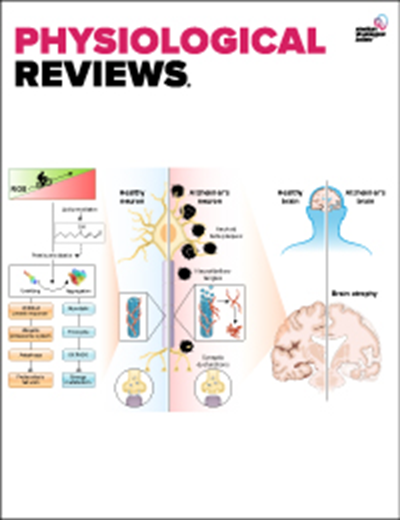硫化氢在哺乳动物细胞、组织和器官中的生理作用。
IF 29.9
1区 医学
Q1 PHYSIOLOGY
引用次数: 72
摘要
H2S属于气体传递分子,它还包括一氧化氮(NO)和一氧化碳(CO)。在各种细胞和组织中,有三种酶被认为是H2S的内源性来源:胱硫氨酸g-裂解酶(CSE)、胱硫氨酸β-合成酶(CBS)和3-巯基丙酮酸硫转移酶(3-MST)。本文综述了这些酶的调控以及它们的酶和非酶降解和消除途径。H2S与其他不稳定的内源性分子(如NO)和活性氧的多种相互作用也被概述。讨论了各种生物靶点和信号通路,特别涉及H2S和蛋白质的氧化转录后修饰,H2S对通道和细胞内第二信使通路的影响,基因转录和翻译的调节以及细胞生物能量和代谢的调节。综述了目前用于研究H2S生理学的药理学和分子工具,包括它们的用途和局限性。在随后的章节中,H2S在各种生理和细胞功能调节中的作用进行了回顾。综述了H2S在各种细胞类型和器官系统中的生理作用。最后,讨论了H2S在调节各种器官功能中的作用以及H2S特有的钟形双相效应。此外,还确定了关键的病理生理方面、有争议的领域以及未来的研究和转化领域。这篇综述揭示了H2S在所有器官功能的生理调节中的一系列重要作用。本文章由计算机程序翻译,如有差异,请以英文原文为准。
Physiological roles of hydrogen sulfide in mammalian cells, tissues and organs.
H2S belongs to the class of molecules known as gasotransmitters, which also includes nitric oxide (NO) and carbon monoxide (CO). Three enzymes are recognized as endogenous sources of H2S in various cells and tissues: cystathionine g-lyase (CSE), cystathionine β-synthase (CBS) and 3-mercaptopyruvate sulfurtransferase (3-MST). The current article reviews the regulation of these enzymes as well as the pathways of their enzymatic and non-enzymatic degradation and elimination. The multiple interactions of H2S with other labile endogenous molecules (e.g. NO) and reactive oxygen species are also outlined. The various biological targets and signaling pathways are discussed, with special reference to H2S and oxidative posttranscriptional modification of proteins, the effect of H2S on channels and intracellular second messenger pathways, the regulation of gene transcription and translation and the regulation of cellular bioenergetics and metabolism. The pharmacological and molecular tools currently available to study H2S physiology are also reviewed, including their utility and limitations. In subsequent sections, the role of H2S in the regulation of various physiological and cellular functions is reviewed. The physiological role of H2S in various cell types and organ systems are overviewed. Finally, the role of H2S in the regulation of various organ functions is discussed as well as the characteristic bell-shaped biphasic effects of H2S. In addition, key pathophysiological aspects, debated areas, and future research and translational areas are identified A wide array of significant roles of H2S in the physiological regulation of all organ functions emerges from this review.
求助全文
通过发布文献求助,成功后即可免费获取论文全文。
去求助
来源期刊

Physiological reviews
医学-生理学
CiteScore
56.50
自引率
0.90%
发文量
53
期刊介绍:
Physiological Reviews is a highly regarded journal that covers timely issues in physiological and biomedical sciences. It is targeted towards physiologists, neuroscientists, cell biologists, biophysicists, and clinicians with a special interest in pathophysiology. The journal has an ISSN of 0031-9333 for print and 1522-1210 for online versions. It has a unique publishing frequency where articles are published individually, but regular quarterly issues are also released in January, April, July, and October. The articles in this journal provide state-of-the-art and comprehensive coverage of various topics. They are valuable for teaching and research purposes as they offer interesting and clearly written updates on important new developments. Physiological Reviews holds a prominent position in the scientific community and consistently ranks as the most impactful journal in the field of physiology.
 求助内容:
求助内容: 应助结果提醒方式:
应助结果提醒方式:


